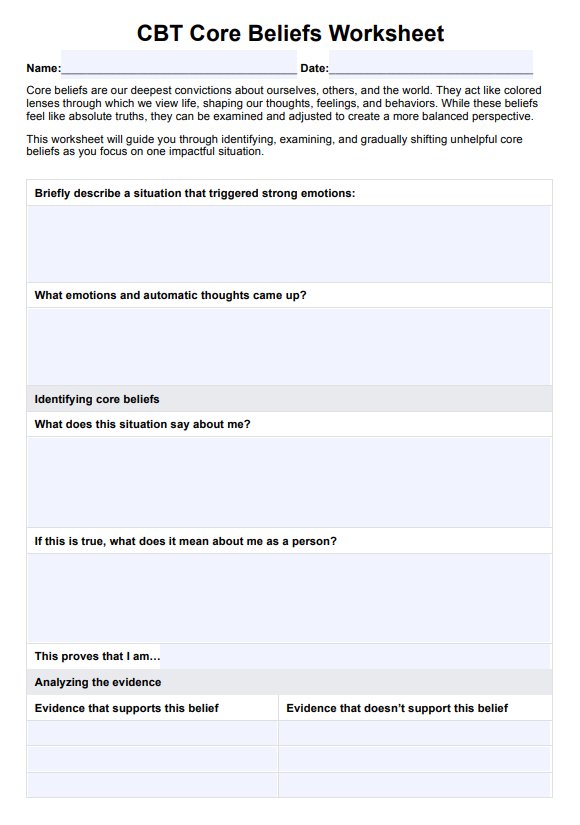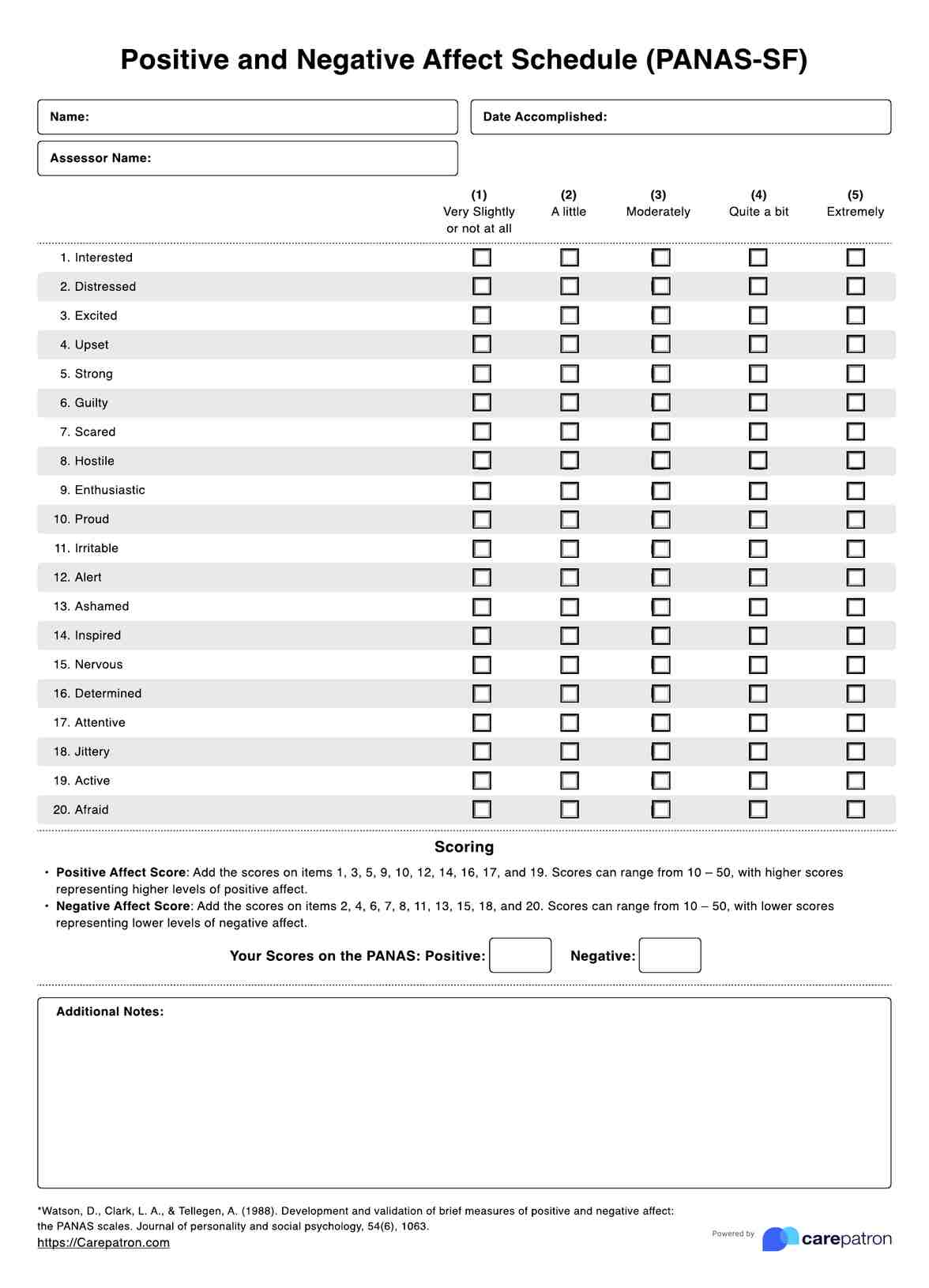Behavior Rating Scale
Introduce behavior rating scales to measure clients' relevant behavioral aspects to inform the next steps to take. Download a free PDF here.


What are Behavior Rating Scales?
As the name suggests, Behavior Rating Scales are used to rate or evaluate specific behaviors. They are typically used by mental health professionals, educators, and caregivers to assess various aspects of an individual's emotions, behaviors, and abilities. These scales may range from evaluating general behaviors such as social skills and attention span to more specific behaviors related to mental disorders like ADHD or depression. They are designed with a series of questions or statements, and responses are selected based on a set scale.
Behavior Rating Scales can be used in various settings:
- Clinical: Mental health professionals often use these scales to support the diagnostic process or track clients' progress throughout treatment.
- Educational: Educators can use these scales to identify and address behavioral issues, learning disorders, or developmental delays in students. This can include teacher rating scales and an educational behavior assessment system.
- Research: Researchers may use these scales to investigate connections between behaviors and other variables, like genetic factors or environmental influences.
These scales are meant to gather information about an individual's behavior in all of these contexts — they are not standalone diagnostic tools. Professional judgment is still crucial in interpreting these ratings and deciding based on the results.
Practitioners also use two main types of scales to understand and evaluate behaviors comprehensively. Each type serves a unique purpose and caters to specific assessment needs.
Broad band rating scales
Broad-band rating scales are designed to provide a wider view of an individual's behavioral and emotional functioning. These scales cover a broad spectrum of potential issues or disorders, effectively assessing a range of emotional and behavioral domains simultaneously. This includes looking into both internalizing behaviors (like anxiety and depression) and externalizing behaviors (such as aggression or hyperactivity).
Given their extensive scope, these scales are quite detailed, sometimes featuring up to 500 items. They are a go-to choice for those seeking an overall assessment of social-emotional functioning to gather more comprehensive information.
Narrow band rating scales
On the other end of the spectrum, narrow-band rating scales offer a closer, more focused examination of behaviors. These scales zero in on specific problem areas or syndromes. Narrow-band scales can provide a detailed analysis of targeted symptoms or behaviors by concentrating on particular aspects of behavior. It usually breaks down the evaluation into focused domains, including problem behaviors and social skills, to give a clear picture of the behaviors related to the specific area of concern.
Behavior Rating Scale Template
Behavior Rating Scale Example
Purpose of Behavior Rating Scales
Behavior Rating Scales are fundamental to different professional fields like psychology, education, and research. But what exactly makes them so vital in these fields? The following aspects shed light on the purpose and the advantages of using behavior rating scales in practice.
Offering insight into behavior
At their core, Behavior Rating Scales are tools designed to provide valuable information about an individual's behavior. This insight can range from general conduct, attention, and emotional state to executive functions, and specific mental health-related behaviors. They help paint a picture that might not be immediately visible through casual observation or brief interactions.
Assisting in diagnosis
One of the primary purposes of these scales is to assist mental health professionals in the diagnostic process. Systematically rating symptoms and behaviors associated with certain conditions like ADHD, anxiety, and depression helps professionals make more informed diagnoses. This systematic approach reduces the likelihood of personal bias affecting the evaluation.
Guiding treatment plans
Once the target behaviors are assessed, it becomes significantly easier to formulate targeted treatment plans. If a scale indicates a child is struggling with particular aspects of emotional regulation, for example, interventions can be specifically designed to address those areas. This ensures a more personalized and, therefore, more effective treatment approach.
Monitor progress
Behavior Rating Scales are not just for initial assessments. They are also important in tracking an individual's behavior changes over time. This is especially critical in therapeutic or educational settings where progress needs to be measured periodically to adjust interventions or teaching strategies accordingly. Seeing tangible improvements or identifying areas that still need work is both motivating for individuals and informative for professionals.
Supporting research
In research contexts, Behavior Rating Scales are instrumental in exploring the relationships between different behaviors and psychological concepts. They provide a standardized and quantitative method for collecting behavior data across different populations and settings, which is important for drawing reliable conclusions in studies.
Examples of Behavior Rating Scales
Behavior Rating Scales are tools used across clinical, educational, and research settings to understand and quantify target behaviors and emotional states. Let's explore some of the well-regarded scales in the field:
Achenbach system of empirically based assessment (ASEBA)
The ASEBA, which includes the Child Behavior Checklist (CBCL), is one of the most comprehensive behavior rating scales. It assesses a wide range of behavioral and emotional problems across different age groups, from 1½ years to over 18 years. The CBCL is particularly notable for its broad application in clinical and research settings to evaluate functioning, diagnose disorders, and plan interventions. It includes teacher, parent, and self-report forms to provide a well-rounded view of the child's behavior across various contexts.
Conners' instruments
Developed for diagnosing Attention Deficit Hyperactivity Disorder (ADHD) and related behavioral issues, the Conners' instruments suite, including the Conners' Rating Scale for Parents, is widely respected. These self report scales provide detailed evaluations across diverse areas such as behavior, academic issues, and emotional disorders. They're available for different respondents: teachers, parents, and adolescents, making them adaptable tools for comprehensive ADHD assessment.
Child behavior rating scale
The Child Behavior Rating Scale by Bronson and colleagues (1990) is a tool used to assess and evaluate children's behavior across various domains. It typically involves parents, teachers, or other caregivers providing ratings or observations of the child's behavior in different situations. The scale helps identify children's behavioral patterns, strengths, and areas of concern, which can be useful for intervention planning and support.
Behavior rating profile (BRP-2)
The BRP-2 is designed to assess children and adolescents' behavior from ages 6.5 to 18 years. This behavior rating scale allows us to gather information about how a child functions in multiple environments, including school and home, emphasizing the different aspects of behavior. It covers various domains such as social skills, academic performance, and personal adjustment, aiding in identifying specific areas needing intervention.
Burk's behavior rating scale (BBRS)
Focused on children in Pre-K to Grade 2, the BBRS evaluates young children's behavior to detect early signs of developmental, emotional, or behavioral issues. This behavior rating scale is particularly useful for parents and educators aiming to understand and address behaviors that may interfere with learning and social interaction at an early stage.
Behavioral and emotional rating scale (BERS)
The BERS is unique in its focus on children and adolescents' strengths. It measures positive behaviors and emotional resilience, providing an alternative perspective that emphasizes what the child is doing well. This positive approach can be particularly motivating and helpful in building self-esteem and developing intervention plans that build on existing strengths.
Behavior assessment system for children (BASC-2)
The BASC-2 is a comprehensive set of tools for assessing children and adolescents' behavior and emotions, spanning ages 2 through 25. It includes self-report and teacher/parent rating scales, classroom observation forms, and a structured developmental history. This behavior rating scale helps diagnose various emotional and behavioral disorders, plan and monitor interventions, and evaluate educational programs' effectiveness.
How to use rating scales
Using Behavior Rating Scales effectively requires several thoughtful steps. Depending on your purpose, this can begin with choosing the appropriate tool to interpret the results and applying them to an intervention plan. To help you navigate this process, we've outlined a general step-by-step guide:
Step 1: Identify the purpose of the assessment
Determine why you need a Behavior Rating Scale. Are you looking to diagnose a particular condition, track treatment progress, or identify areas that require intervention? Your purpose will directly inform the selection of the appropriate scale.
Step 2: Choose the right scale
Select a scale that aligns with your assessment purpose and the age group of the individual you wish to assess. If you're evaluating a child for ADHD, for example, you might choose the Conners instruments. If the aim is to evaluate a specific behavior or aspect, such as resilience, BERS could be a better fit. Then, thoroughly review the scale and its instructions before administering it. This helps ensure you understand the scale's guidelines and can accurately explain the process to the individuals involved.
Step 3: Administer the scale
Collect responses from the relevant party (self, parent, teacher, or a combination). Make sure that they have understood the instructions and that they answer in a comfortable and non-pressured environment.
Step 4: Score and interpret the responses
After the client has taken the test, use the provided guidelines within the scale to score the responses accurately. This commonly involves attributing points to responses and summarizing them according to prescribed methods. Then, the overall score and the scores in each domain will be analyzed against the norms provided by the scale. Look for any areas of concern or patterns that emerge.
Step 5: Apply insights from the results
Use the results from the behavior rating scales to guide diagnosis, intervention planning, or progress monitoring. Remember, tools like the behavior assessment system are helpful methods, but on their own, they cannot replace the need for professional judgment and additional context about the individual's behavior.
Step 6: Monitor changes over time
Conduct follow-up assessments at regular intervals to monitor changes in behavior. Maintaining records makes it easier to note improvement or regression, which is especially valuable when tracking the effectiveness of interventions.
Advantages and limitations of Behavior Rating Scales
Behavior Rating Scales are widely used in various settings, such as schools, clinics, and research, to assess and understand target behaviors and emotional states. These rating scales offer several advantages including the following:
- Comprehensive assessment: These scales allow for a detailed and multifaceted view of an individual's behavior across different environments and contexts including emotional functioning, working memory, and executive function, to possible areas to look into such as social problems and impulse control. This valuable information can then provide a comprehensive picture that individual observations may miss.
- Quantifiable data: A rating scale translates qualitative behaviors into quantifiable data, making it easier to identify problem areas, track changes over time, and measure the effectiveness of interventions.
- Standardization: Behavior Rating Scales are standardized assessment methods, meaning they have been tested for reliability and validity. This standardization ensures that the observations are consistent and can be compared across different individuals or groups.
- Ease of use: Generally, a rating scale is easy to administer, requiring no special equipment or extensive training, making it accessible to many professionals including teachers, other school staff, medical personnel, and social workers.
- Facilitates communication: The quantified data and structured format of these scales make it easier for various stakeholders (e.g., parents, educators, clinicians) to communicate about an individual's needs and progress.
While Behavior Rating Scales gather information and measure cognitive, behavioral, and emotional functioning from different data points, it is also worth considering the following limitations:
- Subjectivity of respondents: Despite the objectivity these scales aim to introduce, responses can be influenced by the subjective perceptions or biases of the individuals completing them, potentially affecting the results.
- Cultural sensitivity: Some scales may not adequately account for cultural differences in behavior or expression of emotions, leading to misinterpretations or inaccurate assessments.
- Overreliance: There's a risk of over-relying on these scales for definitive diagnoses or treatment plans. They should be part of a broader assessment strategy that includes other tools and professional judgment.
- Temporal limitations: The behavior and emotional states are dynamic and can change over short periods. A rating scale provides a snapshot based on past behaviors and might not fully capture an individual's current state.
- Potential for misinterpretation: Without proper training or experience, there's a risk of misinterpreting the results of these scales, which could lead to incorrect conclusions or inadequate interventions.
Next Steps
After understanding the advantages and limitations of Behavior Rating Scales, it's also essential to think about the next steps to take as a practitioner when using them in practice. After interpreting and applying insights gained from the behavior rating scales, consider the following steps:
Collaborate
Don't work in a vacuum. Reach out to other professionals, engage in multidisciplinary teams, and communicate with the parties involved, whether parents, teachers, or individuals. Information from various perspectives can contribute to understanding and using these scales.
Reflect on bias
Remember that our own personal and cultural biases can influence interpretation. By consciously reflecting on these biases and actively seeking to minimize them, practitioners can more accurately and fairly use these scales.
Diversify your toolkit
Make sure that your toolkit includes more than just Behavior Rating Scales. Use them alongside other assessment techniques like observations, interviews, or standardized tests. This diversified approach will give you a more holistic understanding of an individual's behavior.
Regularly monitor and adapt
Embrace the dynamic nature of behavior. Regularly revisit and re-administer these scales to keep track of behavioral changes. Make sure adaptations are made in your strategy based on this feedback loop.
Seek supervision
Never hesitate to seek supervision or consultation when in doubt, especially when interpreting the results or planning interventions. Reaching out to other colleagues can provide a useful check in your practice and can be a source of another perspective.
Reference
Bronson, M. B., Goodson, B. D., Layzer, J. I., & Love, J. M. (1990). Child behavior rating scale. Abt Associates.
Commonly asked questions
Common behavior rating scales include the Behavior Assessment System for Children (BASC), Conners' Rating Scales, Child Behavior Checklist (CBCL), Achenbach System of Empirically Based Assessment (ASEBA), and Social Skills Improvement System Rating Scales (SSiS-RS).
Behavior rating scales cater to a vast age range, typically from early childhood (about two years old), to older children up to adulthood (usually up to 60 years). The specific age range differs from scale to scale. For example, the BASC-3 caters to individuals aged 2-21 years, while the CBCL has different forms for ages 1.5-5 years and 6-18 years.
Behavior rating scales for children evaluate a child's emotional and behavioral functioning. Popular examples include the Behavior Assessment System for Children (BASC), the Child Behavior Checklist (CBCL), and the Conners' Rating Scales. These assessments provide insights into various areas like aggression, impulse control, anxiety, attentional issues, and social skills, among others.


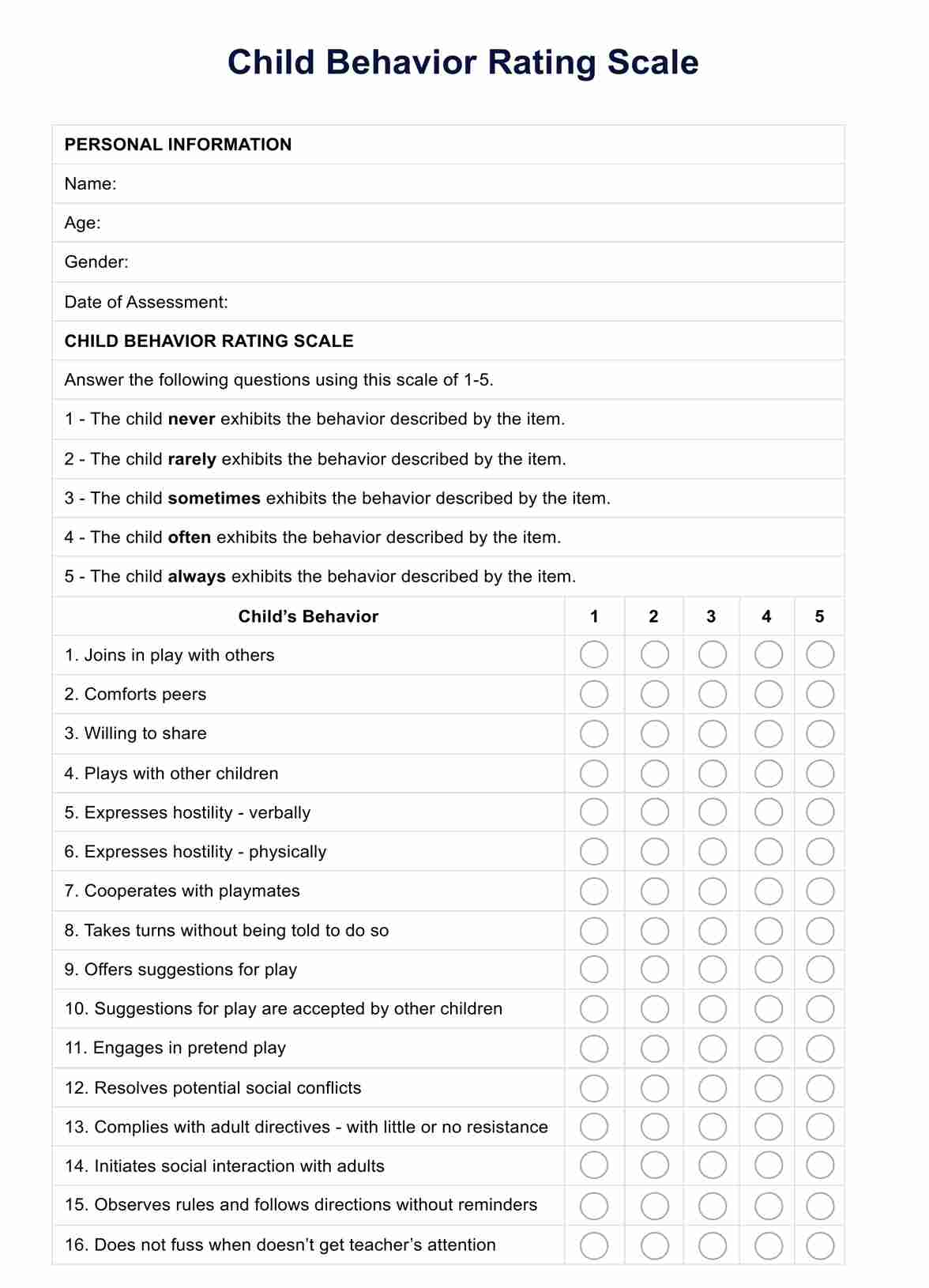
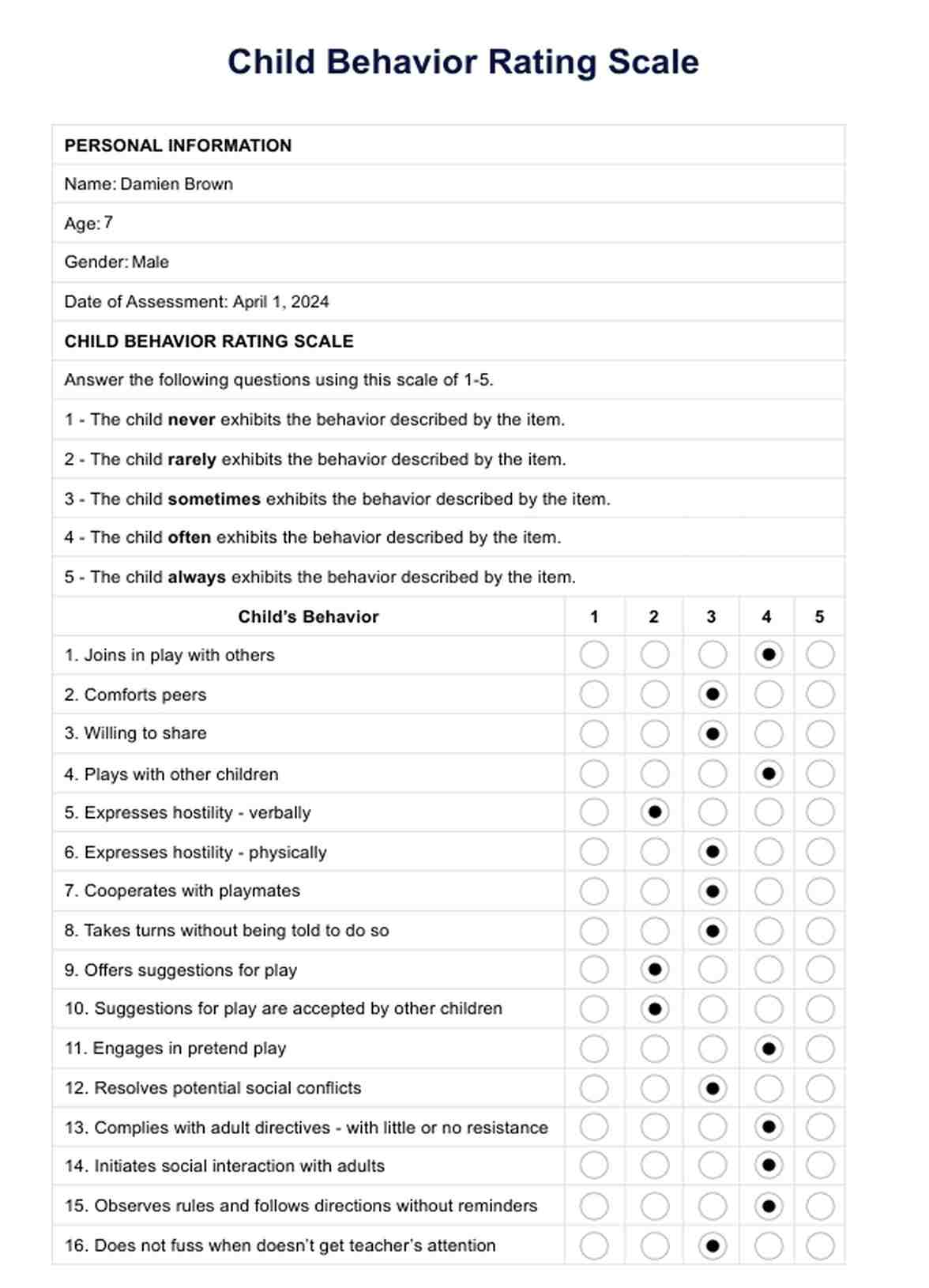

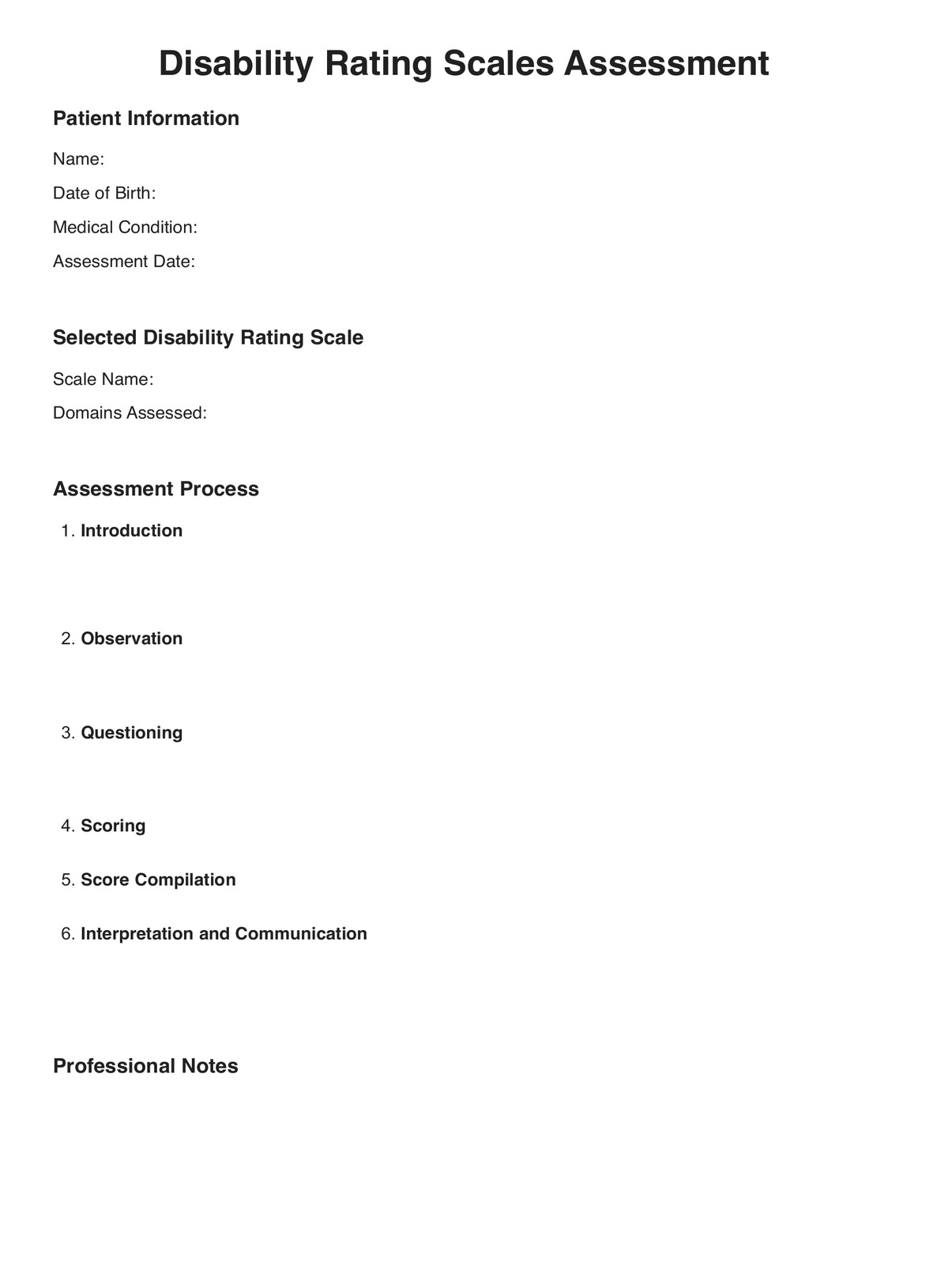
















-template.jpg)


























































































